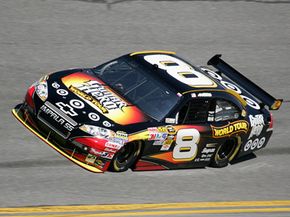Racing and Global Warming
When you see a car doing dozens of laps at close to 200 mph (322 kph), it becomes pretty obvious that aside from the internal-combustion thing going on under the hood, a race car has little in common with the cars we drive to work. But there are more differences than meet the eye.
First, all that power means the gas in the tank doesn't go far. While many commuters grumble if their car gets less than 20 miles per gallon fuel efficiency, and some cars out there get 50 mpg, 5 miles per gallon is standard for a NASCAR car. Also, the devices that the U.S. Environmental Protection Agency (EPA) has mandated on normal cars to keep emissions to a safe level, like catalytic converters, are not built into race cars. NASCAR race cars are only regulated by NASCAR.
Advertisement
This all adds up to some serious fuel consumption. In a single typical NASCAR race weekend, with more than 40 cars at high speeds for 500 miles (804 kilometers) -- plus practice laps -- at 5 mpg of gas, you're looking at, conservatively, about 6,000 gallons (22,712 liters) of fuel [source: Finney]. Each gallon burned emits about 20 pounds (9 kilograms) of carbon dioxide, so that's about 120,000 pounds (54,431 kilograms) of CO2 for a race weekend [source: FuelEconomy]. Multiply that by roughly 35 races per year, and NASCAR's annual carbon footprint is in the area of 4 million pounds (1.8 million kilograms).
Yes, that's a lot. The energy expended in one race could power more than three houses or drive seven cars for a whole year [source: Shelby]. But is it a lot in the grand scheme of things?
It depends on how you look at it. That 6,000 gallons (22,712 liters) of gas over two days starts to look somewhat reasonable when you consider that the United States eats up about 400 million gallons (1.5 billion liters) per day, any old day of the year [source: Finney]. And 4 million pounds a year doesn't seem like much compared to the world's 6 billion tons (5.4 billion metric tons) of CO2 emissions every year, or the 1 million tons (907,184 metric tons) emitted for the one day of the 2005 Super Bowl [source: Fulton].
But it's an extravagantly high number next to the 45,000 pounds (20,411 kilograms) of CO2 the average American life emits in a whole year.
So where does that leave us? With a sport that, while it may not be single-handedly sending the human race into a warm extinction, could definitely use some greening up. And change is actually not that far off.
